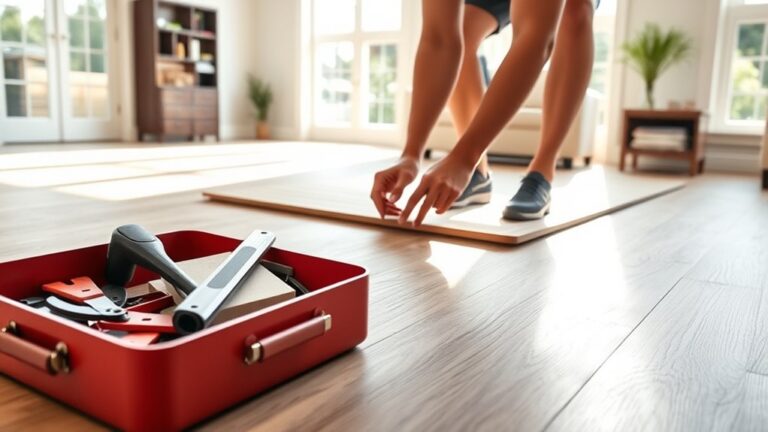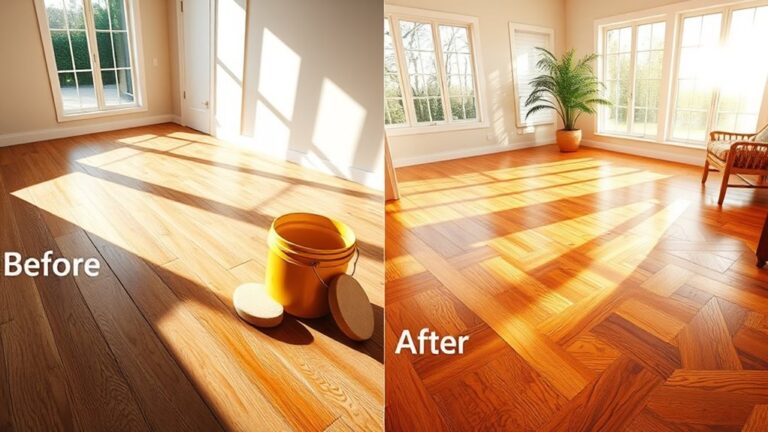To paint laminate floors, first gather quality primer and paint made for laminate, plus fine sandpaper and cleaning supplies. Clean and lightly sand the floor to roughen the surface for better adhesion, then thoroughly remove dust. Apply a laminate-specific primer evenly and let it dry completely. Paint with thin coats of durable, satin-finish paint, allowing each layer to cure fully. Finish by sealing the floor for long-lasting protection. Follow these steps carefully, and you’ll achieve a smooth, lasting finish—more detailed guidance can help you perfect the process.
Gather the Necessary Supplies

Before you begin painting your laminate floors, you’ll need to gather all the necessary supplies to guarantee a smooth and efficient process. Start with selecting quality paint brands known for durability and adhesion on laminate surfaces; acrylic latex or epoxy-based paints are excellent choices. Get a primer designed for laminate floors to make certain paint bonds well. You’ll also want fine-grit sandpaper to lightly roughen the floor textures, promoting better paint grip. Equip yourself with a paint roller suited for smooth surfaces, angled brushes for edges, painter’s tape for clean lines, and drop cloths to protect surrounding areas. Don’t forget a mild cleaner and microfiber cloths for dust removal before priming. Having these precise tools and materials ready frees you to work confidently and achieve lasting results.
Clean and Prepare the Floor Surface
Start by thoroughly removing all dirt and debris from the floor using a vacuum and a damp mop to guarantee a clean surface. Inspect the laminate closely for any scratches or dents, and use a suitable filler or putty to repair these imperfections. Allow the repairs to dry completely before sanding lightly to create an even, smooth base for painting.
Remove Dirt and Debris
Anyone tackling the task of painting laminate floors will want to guarantee the surface is impeccably clean. Removing dirt and debris is essential for paint adhesion and a smooth finish. Use effective tools and proven cleaning techniques to prepare your floor. Start by sweeping or vacuuming thoroughly to eliminate loose particles. Then, mop the floor with a gentle cleaner, avoiding harsh chemicals that could damage the laminate. Don’t forget to dry the surface completely before proceeding. Here’s a quick checklist to guide you:
- Sweep or vacuum to remove dust and grit
- Use a microfiber mop with a mild detergent
- Avoid soaking the floor; use minimal water
- Wipe away any sticky residues with isopropyl alcohol
- Let the floor dry fully before painting
This method guarantees your floor is ready for a flawless paint job.
Repair Surface Imperfections
To achieve a smooth, professional-looking finish, you’ll need to carefully repair any surface imperfections on your laminate floor. Start by inspecting the floor for cracks, chips, or dents. Use a laminate floor filler or wood putty designed for filling cracks; apply it with a putty knife, pressing firmly to fill gaps completely. Once dry, sand the filled areas gently with fine-grit sandpaper to guarantee smoothing surfaces blend seamlessly with the surrounding floor. Wipe away dust with a damp cloth, then allow the floor to dry fully. This preparation step is essential—it eliminates unevenness that would show through paint, assuring your floor looks flawless and lasts longer. Taking the time to repair now frees you from worrying about imperfections later.
Sand the Laminate Flooring

You’ll want to start sanding with a fine-grit sandpaper, around 120 to 150 grit, to lightly scuff the laminate surface without damaging it. Use gentle, even strokes in the direction of the grain to guarantee smoothness and better paint adhesion. Remember to wear a dust mask and clean up all sanding dust thoroughly before moving on.
Choosing the Right Grit
Selecting the right grit sandpaper is essential for properly preparing laminate floors for paint. Your grit selection determines how effectively you remove the glossy finish without damaging the surface. When considering sanding options, aim for a balance between smoothing the floor and preserving its integrity.
Here’s what to keep in mind:
- Start with 120-150 grit for initial light sanding to scuff the surface.
- Avoid coarse grits (below 80) to prevent deep scratches.
- Finish with 220 grit for a smooth, paint-ready surface.
- Use finer grits for less aggressive sanding on newer floors.
- Test your sanding approach on a small area first.
Choosing the right grit guarantees your paint adheres well and lasts longer, giving you the freedom to transform your laminate floor confidently.
Sanding Techniques and Tips
Once you’ve chosen the appropriate grit sandpaper, it’s time to focus on the sanding process itself. Start by selecting the right sanding tools—an orbital sander works best for large areas, while a sanding block is ideal for edges and corners. Use even, controlled pressure to avoid damaging the laminate surface. Apply consistent, overlapping strokes following the grain direction to guarantee a smooth finish. Avoid excessive sanding; your goal is to dull the glossy finish, not strip the laminate entirely. Between passes, wipe away dust with a tack cloth to monitor progress clearly. Remember, proper sanding techniques help the paint adhere better, giving you freedom to customize your floor confidently. Take your time and keep your workspace well-ventilated for the best results.
Remove Dust and Debris
Before applying any paint, thoroughly removing all dust and debris from your laminate floor is essential to guarantee proper adhesion. Effective dust removal and debris management assure your paint job lasts longer and looks flawless. Start by vacuuming the entire floor to pick up loose particles. Follow with a damp microfiber mop to catch fine dust without saturating the surface. Focus on corners and edges where debris tends to accumulate. Finally, wipe the floor with a tack cloth to grab any remaining particles that might interfere with paint bonding.
- Vacuum all dust and loose debris thoroughly
- Mop with a slightly damp microfiber cloth
- Pay extra attention to corners and seams
- Use a tack cloth for final dust pickup
- Allow the floor to dry completely before painting
This precise routine sets the stage for a smooth, durable finish.
Apply a Primer Suitable for Laminate

Applying the right primer is essential for ensuring your paint adheres properly to laminate floors and lasts over time. Start by selecting a primer specifically designed for laminate surfaces—usually bonding primers or shellac-based primers work best. These primer types create a strong base, preventing peeling or chipping. Before primer application, make sure your floor is clean and dry. Use a high-quality brush or roller to apply a thin, even coat, working in small sections to avoid drips. Allow the primer to dry completely, following the manufacturer’s recommended drying time. Avoid heavy application, as thick layers can cause uneven surfaces. Proper primer application guarantees better paint adhesion, durability, and a smooth finish, giving you the freedom to enjoy your refreshed laminate floor confidently.
Choose the Right Paint for Laminate Floors
When selecting paint for your laminate floors, you’ll want to focus on products that offer strong adhesion, durability, and resistance to wear. Not all laminate paint types perform equally, so choose one designed specifically for floors to guarantee floor paint durability. Look for paints that can withstand foot traffic and cleaning without chipping or fading.
Consider these key points when choosing your paint:
- Acrylic latex paints: Flexible and durable, ideal for laminate surfaces
- Epoxy floor paints: Provide excellent hardness and chemical resistance
- Oil-based paints: Offer strong adhesion but longer drying times
- Paints labeled for floors: Guarantee resistance to scuffs and scratches
- Low-VOC options: Keep indoor air quality safe during application
Picking the right paint sets the foundation for a lasting, beautiful finish.
Apply the First Coat of Paint
Start by selecting a paint specifically designed for laminate surfaces to guarantee proper adhesion. Apply the paint using smooth, even brush strokes to avoid streaks and bubbles. After finishing, let the first coat dry completely before moving on to the next step.
Choose Suitable Paint Type
Selecting the right paint is essential for achieving a durable finish on laminate floors. You want a product specifically designed for laminate surfaces to guarantee proper adhesion and longevity. When choosing among laminate paint types, take into account both durability and flexibility to resist chipping or peeling under foot traffic. Also, evaluate paint finish options to match your style and practical needs.
Here are key points to take into account:
- Use epoxy or urethane-acrylic paints for strong, lasting coverage
- Opt for satin or semi-gloss finishes for easy cleaning and subtle shine
- Avoid flat or matte finishes, as they may wear quickly
- Check for low-VOC formulas to maintain indoor air quality
- Confirm compatibility with laminate surfaces to prevent peeling
This careful selection sets the foundation for a successful floor transformation.
Use Even Brush Strokes
Apply the paint using even brush strokes to guarantee a smooth, consistent first coat on your laminate floor. Start by loading your brush evenly—not too much paint to avoid drips, not too little to prevent patchiness. Use long, steady strokes aligned with the floor’s grain or the room’s length to maintain stroke consistency. Employ proper brush techniques: hold the brush at a slight angle and apply gentle pressure for control. Overlap each stroke slightly to blend edges seamlessly. Avoid going back and forth excessively; instead, move forward steadily to minimize brush marks. This approach assures an even distribution of paint, creating a flawless base layer that sets the stage for a durable, beautiful finish. Mastering these brush techniques gives you the freedom to transform your floor with precision and ease.
Allow Proper Drying Time
Although you’ve just finished brushing on the first coat, you’ll need to let it dry thoroughly before proceeding. Proper drying time is essential for ensuring a durable finish on your laminate floor. Focus on creating an ideal drying environment by controlling temperature, humidity, and airflow. Different drying techniques can speed or slow this process, but patience is key. Follow these tips:
- Keep the room temperature between 65°F and 75°F for consistent drying.
- Maintain low humidity to prevent paint from staying tacky.
- Use fans or open windows to improve air circulation.
- Avoid walking on the floor until it’s fully dry to prevent smudges.
- Check the paint manufacturer’s recommended drying time and adhere strictly.
This approach guarantees your floor paint sets evenly, giving you freedom to enjoy a flawless finish.
Allow the Paint to Dry Completely
Since the paint needs to fully cure before you can walk on or place furniture over it, you should allow at least 24 to 48 hours of drying time, depending on the paint type and room conditions. To guarantee proper paint curing, maintain consistent room temperature and low humidity, as these drying techniques speed up the process and prevent tackiness. Avoid rushing by keeping the area well-ventilated but free from dust and debris that could mar the finish. Resist the urge to test the floor’s dryness prematurely—gently touch an inconspicuous spot to check if the paint feels firm and no longer sticky. Remember, complete drying is essential to achieve a durable, long-lasting surface that withstands daily use and preserves your freedom to enjoy the space without worries.
Apply Additional Coats if Needed
Once your first coat has dried completely and feels firm to the touch, you’ll want to assess the coverage and finish. If it’s uneven or too thin, applying additional coats can perfect the look. Use layering techniques to build a smooth, rich surface without drips or streaks. This step also allows you to explore additional color options, adjusting depth or tone as you go.
After the first coat dries, evaluate coverage and apply more layers to achieve a rich, even finish.
When applying extra coats, keep these tips in mind:
- Lightly sand between coats for better adhesion
- Apply thin, even layers to avoid pooling
- Allow each coat to dry fully before the next
- Test additional color options on a small area first
- Maintain consistent brush or roller strokes for uniformity
This approach guarantees a durable, vibrant floor you’re proud of.
Seal the Painted Floor for Durability
Before you start sealing, make sure your painted laminate floor is completely dry and free of dust or debris. Choosing the right floor sealant options is essential to maximize durability factors like scratch resistance and moisture protection. Use a high-quality polyurethane or water-based sealant applied evenly with a brush or roller. Let each coat dry fully before applying the next.
| Sealant Type | Application Method | Durability Factors |
|---|---|---|
| Oil-based Polyurethane | Brush or roller | High scratch resistance |
| Water-based Polyurethane | Roller | Low odor, quick drying |
| Acrylic Sealant | Spray or brush | Flexible, UV resistant |
| Epoxy | Roller | Extremely durable |
| Wax-based | Cloth | Easy to reapply |
Proper sealing extends your floor’s lifespan and preserves its fresh look.




